Small, fast-scaling brands are finding that today’s marketing challenges extend beyond ad spend and algorithms. Also due to the nonstop demand for fresh content, the economics of live selling and the complexities of attribution, founders are making fundamental changes to how they operate.
During a recent Glossy+ focus group, founders from swimwear, intimates, and jewelry brands shared the strategies reshaping their day-to-day marketing strategies.
Focus group members:
- Bette Bentley, founder of Skimpies, the patented “strapless bra of undies” designed to feel like going commando while providing full coverage and support, created specifically for wearing under leggings.
- Hayley Segar, founder of Onewith, a patent-pending swimwear brand designed to fit like no-show underwear. Onewith launched in 2021 and was featured on “Shark Tank” in January 2025.
- Mike Cooke, founder of Sterling Forever, a 10-year-old women’s jewelry brand known for celebrity-inspired and designer dupe pieces, sold direct to consumer and through retailers including Nordstrom.
Meeting content demands without burning out
The pressure to post constantly is real, but brands are finding efficiencies. “We aim for at least one post per day and use Repurpose.io to automatically push it to TikTok, YouTube Shorts and other platforms,” said Hayley Segar, founder of Onewith. “I batch everything on one day a month and keep it in a ready-to-post folder. We also recently started retaining creators to diversify our voice, so it’s not just me all the time.”
For Skimpies founder Bette Bentley, the challenge is staying personally visible: “Our biggest viral moments come from raw before-and-after videos, even if that means millions of views of camel-toe solutions. The hardest part isn’t the amount of content, it’s putting myself out there that much.”
Even brands with in-house creative teams struggle to keep up. “We have a full-time photographer and videographer, and it’s still not enough,” said Sterling Forever founder Mike Cooke. “Now, TikTok creators are part of our core strategy.”
Customers as creators and affiliates
Brands are tapping customers to fill the content pipeline. “If someone posts a great TikTok, we ask to license it as an ad and pay them,” Segar said. “Our top performer right now came from a mom filming in her bedroom saying, ‘I’ve never felt this good in a swimsuit.’ It’s beating everything polished in our library.”
Bentley said affiliates are also part of the solution: “We’re relaunching our affiliate program with incentives. Even before, affiliates created videos we could repurpose. It’s valuable because it brings diversity to the brand voice and lets customers see themselves represented.”
Attribution, platform hurdles and new growth channels
The founders agreed that measuring marketing success means looking beyond one platform’s ROAS. “Attribution is messy, so we look at total P&L across channels,” Cooke said. “TikTok might not break even directly, but it’s lifted our Nordstrom Rack sales by triple digits. That halo effect is real.”
Segar uses attribution platform Triple Whale to reveal long-term returns: “Campaigns that look like a 2x return on the surface often turn out to be 8x when you see the full impact.” Bentley added that TikTok’s granular data helps her pinpoint what messages convert: “You can literally see what second in a live caused someone to add to cart.”
But platform expansion hasn’t been simple. “We’ve tried Flip, Snapchat, Pinterest, … and we get kicked off most of them because of our product category,” Segar said. Bentley has had content flagged for discussing women’s health. “Talking about discharge gets taken down, which is ridiculous,” she said. “I don’t want my daughter growing up thinking that’s taboo.”
One bright spot: Reddit. “I jump into threads about underwear solutions and link Skimpies, and you can often see sales spike from those conversations,” Bentley said.
Live selling moves in-house
Live selling has become core to revenue and brand storytelling, but outsourcing it is costly. “We hired a firm in L.A. at $150 an hour to host TikTok Lives, but it’s tough to make money at that rate,” Cooke said. “Now we’re building a studio in Florida and hiring our own host for $30 an hour and a moderator for $18. It’s the only way to make live selling profitable for us.”
Skimpies initially tried a high-production studio approach but found that customers preferred a homegrown look. “I sold out of my kitchen, at first, then moved to a studio, and sales dropped,” Bentley said. “People liked the home vibe — my husband walking in, the casual background. So we leaned into that, and it became part of the brand story.”




